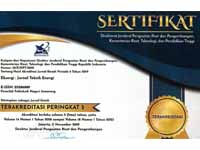Analysis of the Effect of PWHT on the Corrosion Test of API 5L X65 Material in Submerged Arc Welding
DOI:
https://doi.org/10.32497/eksergi.v20i03.5828Keywords:
API 5L X65, Hydrogen Induced Cracking, PWHT, Residual Stress, SAWAbstract
This research discusses the method of making distribution pipes using the Submerged Arc Welding (SAW) welding process, especially for pipes with spiral connections. The material used is API 5L X65. SAW pipes with spiral joints are more commonly used for low-pressure piping systems. However, in certain cases, the production of SAW pipes for Sour Service distribution requires special treatment. Sour Service pipes have a high level of corrosion and residual stress, so Post Weld Heat Treatment (PWHT) is required to prevent Hydrogen Induced Cracking (HIC). HIC occurs due to the absorption and accumulation of hydrogen gas in the metal, causing the formation and growth of cracks, which is also influenced by residual stress. PWHT is applied to reduce residual stress to reduce the risk of corrosion. PWHT is a process to change the structure of the weld metal by heating the metal at a certain temperature and time. This research shows that variations in PWHT temperature produce an average residual stress that is not much different with less difference than 2%, In corrosion testing with the HIC method shows crack evidence but is still satisfactory NACE MR0175 criteria for pipe PWHT temperature variation conditions.References
M. A. Al-Anezi, T. A. Al-Ghamdi, W. L. Al-Otaibi, and S. M. Al-Muaili, “Chapter 19 - Manufacturing, testing, and operational techniques to prevent sour service damages,” A. S. H. Makhlouf and M. B. T.-H. of M. F. A. with C. S. from the O. and G. I. Aliofkhazraei, Eds. Butterworth-Heinemann, 2016, pp. 393”“410. doi: https://doi.org/10.1016/B978-0-08-100117-2.00018-2.
B. Perdana, S., Budiarto, U., Wibawa, A., & Santosa, “Pengaruh Variasi Waktu Penahanan (Holding Time) pada Perlakuan Panas Normalizing Setelah Pengelasan Submerged Arc Welding (SAW) pada Baja SS400 terhadap Kekuatan Tarik, Tekuk dan Mikrografi,” J. Tek. Perkapalan, vol. 8, no. 1, 2020.
B. Iman Fatkurokhim, “Analisa Pengaruh Tegangan Sisa Dan Perubahan Distorsi Pada Pengelasan Struktur Pressure Vessels Pt. Petrokimia Gresik Dengan Variasi Welding Sequence Dengan Menggunakan Metode Elemen Hingga,” p. 67, 2017.
A. Sawaldi, A. F. Al Fathier, and A. Ibrahim, “Pengaruh PWHT terhadap Struktur Mikro pada Lasan Pipa Baja ASTM A106 Grade B,” J. Weld. Technol., vol. 1, no. 2, pp. 31”“35, 2019, doi: 10.30811/jowt.v1i2.1643.
A. Multazam, “HARDENES PROCCES CONTROL BAJA TAMBANG DENGAN QUENCHING METHOD,” vol. 3, no. 1, pp. 56”“62, 2017.
N. I. Golikov, “Effect of Residual Stress on Crack Development in Longitudinal Welded Joints of a Gas Pipeline,” Procedia Struct. Integr., vol. 30, pp. 28”“32, 2020, doi: https://doi.org/10.1016/j.prostr.2020.12.006.
A. P. Institute, “API 5L Specification for line pipe,” Api Spec 5L, vol. Forty Four, pp. 1”“40, 2007.
O. T. Wiryosumarto H, “Teknologi Pengelasan,” Teknol. Pengelasan Logam=Welding Eng., 1994.
NACE TM0284, “Standard Test Method Evaluation of Pipeline and Pressure Vessel Steels for Resistance to Hydrogen-Induced Cracking,” NACE Int., no. 21215, p. 20, 2011.
W. Cheng and I. Finnie, Residual Stress Measurement and the Slitting Method. 2007. doi: 10.1007/978-0-387-39030-7.
A. F. Z. Hristo Anggigi, Untung Budiarto, “Analisa Pengaruh Temperatur Normalizing Pada Sambungan Las SMAW (Shielded Metal Arc Welding) Terhadap Kekuatan Tarik , Tekuk dan Mikrografi Baja Karbon Rendah,” J. Tek. Perkapalan, vol. 7, no. 2, pp. 504”“513, 2019.
S. Gawor, “evaluation of HIC resistance in two X70 pipeline steels using ultrasonic testing,” pp. 1”“187, 2019.
I. Setiawan and M. N. Ilman, “Pengaruh Post Weld Heat TreatmentTerhadap Sifat Mekanis dan Korosi Sambungan Las Spiral Saw pada Pipa Baja ASTM A252,” J. Energi Dan Manufaktur, vol. 5, no. 1, pp. 67”“75, 2013.
T. Dai, R. Thodla, W. Kovacs, K. Tummala, and J. Lippold, “Effect of postweld heat treatment on the sulfide stress cracking of dissimilar welds of nickel-based alloy 625 on steels,” Corrosion, vol. 75, no. 6, pp. 641”“656, 2019, doi: 10.5006/3081.
NACE MR0175, “ANSI NACE MR0175 / ISO 15156 : Materials for use in H 2 S-containing environments in oil and gas production,” pp. 0”“19, 2015.
Downloads
Published
Issue
Section
License
Copyright (c) 2024 Eksergi : Jurnal Teknik Energi

This work is licensed under a Creative Commons Attribution 4.0 International License.
Authors who publish with this journal agree to the following terms:Authors retain copyright and grant the journal right of first publication with the work simultaneously licensed under a Creative Commons Attribution License that allows others to share the work with an acknowledgement of the work's authorship and initial publication in this journal.
Authors are able to enter into separate, additional contractual arrangements for the non-exclusive distribution of the journal's published version of the work (e.g., post it to an institutional repository or publish it in a book), with an acknowledgement of its initial publication in this journal.
Authors are permitted and encouraged to post their work online (e.g., in institutional repositories or on their website) prior to and during the submission process, as it can lead to productive exchanges, as well as earlier and greater citation of published work (See The Effect of Open Access).






